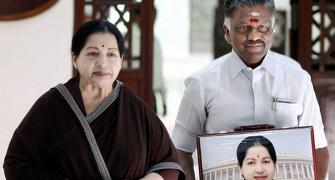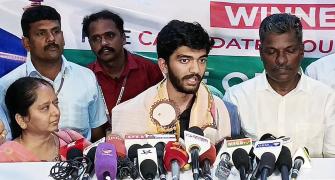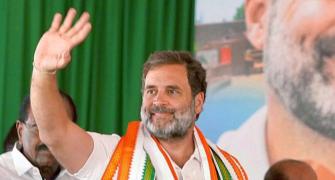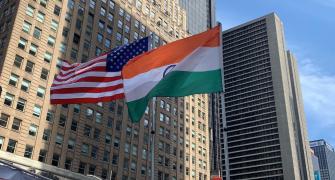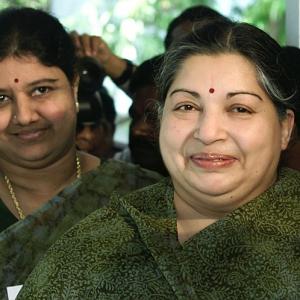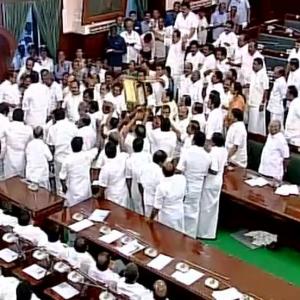Now that an elected chief minister is at the helm, it is high time the Centre initiate discussions to appoint a full-time governor at the earliest, given that the state is set to face some challenging times, says N Sathiya Moorthy.

With acting Governor Ch Vidyasagar Rao returning to his gubernatorial base in Mumbai after last week’s high drama, both inside and outside the state assembly in Chennai, the question arises as to when -- and not if -- Tamil Nadu would get a full-time gubernatorial assignee.
This is because almost since the hospitalisation of Chief Minister Jayalalithaa in September last year, and more so after the sudden exit and subsequent retraction of her party-chosen successor O Panneerselvam, or OPS, the role of the governor became more crucial than ever in the past, and an acting governor, operating mostly out of the state, was seen as a part of the problem(s), and not as the constitutionally-mandated provider of timely solution(s).
Suffice to recall that on the afternoon when OPS quit and proposed ruling AIADMK general secretary, V K Sasikala, as his successor, Rao was flying out of Coimbatore to New Delhi, for attending a private function.
From there, he moved on to Mumbai, where he either stayed in the Raj Bhavan or attended to some prior engagements, none of which, it would seem, was as critical and serious as the evolving political situation in Tamil Nadu.
The question thus arises that if only Rao had flown in to Chennai, instead of Delhi on that crucial Sunday afternoon, would outgoing chief minister OPS have confided in the acting governor that his resignation and hence subsequent proposal of Sasikala’s name in his place were not of his own volition, as implied in the relevant provisions of the Constitution?
The Constitution mandates that ministerial resignations have to be in one’s own hand, implying that even if only a finger-print and not a signature, the governor would have to assure himself that it was not done under coercion or duress.
As subsequent events proved, OPS’s resignation, and its not-so-delayed acceptance, caused the subsequent developments, starting with his claims to ‘forced resignation’ nearly 48 hours later.
Before returning to Mumbai, Rao received delegations of ruling AIADMK under the new CM, Edappadi K Palaniswami, a DMK team of Rajya Sabha members, and a third one led by ‘AIADMK rebels’ (for want of a better phrase) and ‘outgoing CM’ Panneer.
In their meetings with the governor, the three delegations gave him an account of their perceptions of the trust vote that the governor had ordered in order for Palaniswami to prove his majority on the floor of the House, as ordained by the Supreme Court in the ‘S R Bommai case’ verdict in 1994.
Fair enough, the Bommai verdict also stated that the speaker was the boss inside the assembly, but given the circumstances the court had not considered possible in 1994, could Rao have directed Speaker P Dhanapal to consider a ‘secret vote’ as a real possibility?
Likewise, could Rao have directed the speaker to permit an independent observer or observers, nominated by the Raj Bhavan to report back to him after the vote?
If these issues were flagged before the court, and if the nation’s highest judiciary did not approve of his ways, then he would still be seen by the Tamil Nadu voter as having ‘erred’ on the right side.
Governor Rao is a knowledgeable politician, from undivided Andhra Pradesh. A BJP parliamentarian and an RSS pracharak in his earlier avatar, he had served as minister of state at the Centre in the Vajpayee-led NDA government.
A part of his innings as MoS was spent in the Union home ministry, which is concerned with the role, activities and reports of state governors, especially on occasions such as this.
This, and Rao’s knowledge of the Constitution as a lawyer, should have prepared him well for his present job. So should the long hospitalisation of then chief minister Jayalalithaa have alerted him to the possibilities of the kind.
In recent times, he would have also followed the gubernatorial career of one-time party colleague, Jyoti Prasad Rajkhowa, who would not quit as Arunachal Pradesh governor even after the Supreme Court had castigated him for his conduct over ‘defection-induced’ change of government in the sensitive north-eastern state.
Today, in the absence of an ‘independent observer’ report, the governor would still have to rely, technically, on the speaker’s verdict and communication.
The Centre and the President, if they were to act on his report, if it’s adverse to the speaker’s communication and the Palaniswami government, all three would have to explain their conduct even more to the Supreme Court.
After all, the Bommai verdict clearly mandates that any dissolution of the assembly and/or dismissal of a state government would suo motu be taken up for early hearing and disposal by the Supreme Court.
The court verdict would be final and binding on all parties concerned, the SC had declared in the Bommai judgment.
All this does not mean that Governor Rao did not do his part well. But a full-time governor would have glued his ears to the ground, full-time, and not be distracted by gubernatorial commitments in his parent state, or otherwise, too.
Today, there are more problems for the Palaniswami government and the Sasikala faction of the ruling AIADMK than is acknowledged. The government has to present the Budget for 2017-18 soon and get it passed by March 31 in the assembly.
There are also other issues, bills and resolutions that would come up before the assembly for debate and vote, almost on a daily basis.
The controversy surrounding the trust vote has brought all non-Sasikala faction parties and groups on the same side. This means, with the DMK’s 89 MLAs, and those of the Congress ally’s eight and IUML’s one, the OPS faction’s 11 legislators may vote against the government, whatever the issue, whatever the occasion.
The bonhomie that the DMK-led Opposition had displayed since the May 2016 elections, despite being spurned repeatedly by the Jayalalithaa government but was acknowledged with grace by the OPS leadership, cannot be expected any more.
In effect, all of it would mean that the anti-government parties would together have a total of 109 MLAs in a House with an effective strength of 233 (following the vacancy created by Jaya’s death).
That would mean that the ‘opposition’ would require only 117 votes, to send the Palaniswami team packing, even with the Speaker’s casting vote.
They would thus have to look at eight more MLAs to cross over, even as the OPS faction should be guarding its own flock against ‘poaching’ before the ‘official faction’ gets down to the business of seeking the ‘disqualification’ of ‘select’ rebels.
Indications are that the DMK, if offered the mandatory chance of forming a government, should the Panaliswami team lose a floor test of any kind, might opt out, and seek fresh elections to the assembly. It could happen as early as a year, if not less.
Even otherwise, with periodic polls due in the next five years -- local government elections in 2017, Lok Sabha polls in 2019 and that for the state assembly in 2021 -- neither of them can hope to face any of them without the MGR-Jaya ‘Two Leaves’ symbol.
The two AIADMK factions may thus have to consider re-unification as a possibility.
As the OPS camp has started pointing out belatedly and not when their leader Panneer was proposing Sasikala’s name for the party general secretary’s post after Jaya’s exit, the position can be filled only through a vote by all 1.5-crore registered members.
It’s another matter that neither MGR, nor Jaya in their time, was elected to the post this way.
Nor were MGR’s nominated replacements in V R Nedunchezhiyan, or V Ragavanandam, whenever.
However, possibly anticipating trouble of the kind on a future date, the Sasi camp is believed to have obtained the signatures of many, if not a majority, of registered members of the party with proof of identification at the local levels, after the party general council had ‘unanimously’ elected her as the party boss, on the resolution moved by OPS, already CM.
The question would thus arise if a person who had been CM could claim to have been ‘forced’ into proposing Sasi’s name for two different positions, one of them mandated by the nation’s Constitution, with such casualness unbecoming of an incumbent chief minister of a fairly large and mainstream state.
If perceptions, especially in the social media, were to prove right, and the OPS camp, possibly with some assistance now from Jaya’s niece J Deepa, were to prove right, then the ‘Sasi faction’, as is identified at least as of now, may have a tough time retaining the ‘Two Leaves’ symbol.
That could be among the clinching issues in the coming days, weeks and months, for a long drawn-out legal battle before the Election Commission first and possibly in the Supreme Court later on could cause further tremors in the party, at times within the state assembly, too.
Independent of all this could be the upcoming presidential polls in July, where the split AIADMK in the two Houses of Parliament with the second highest total of 49 MPs, and their counterparts in the state assembly with the pre-split total of 135 would matter the most -- and not just for the factions or the state alone, but for the national parties and their strategists, from multiple directions.
A clearer picture on that score could emerge after the results of the ongoing five-state assembly polls are known on March 11.
All of it could well demand that Tamil Nadu gets a new governor at the earliest, and he too has enough time to study the ground situation and is seized of the possibilities and probabilities, without getting caught, as if unawares.
What’s more, unlike when Rao had to take additional charge when incumbent K Rosaiah retired, today the State has a CM with whom the Centre could hold the conventional consultations before naming a new governor.
Of course, a lot on this score again would depend on what Rao has to report to the Centre and the President, if at all he has any, after the trust vote, where CM Palaniswami won the vote, though not necessarily the trust of the state.
Independent of what acting governor Rao can and would do, the Centre may have to actively consider the appointment of a full-time gubernatorial tenant for the sprawling Raj Bhavan in Chennai.
Though there was/is no constitutional bar on the Centre/President appointing a governor only in consultation with the state government, represented by the chief minister, successive PMs have followed the convention, though with rare exceptions.
In the case of TN, CM Jaya was hospitalised for long, yes, but that did not deter acting governor Rao to direct senior-most minister OPS to chair cabinet meetings and look after the portfolios under her care.
Even after Jaya’s death and OPS had been sworn in CM in a midnight function in the Raj Bhavan, the Centre was not known to have taken any initiative for the appointment of a full-time governor for the state, through mutual consultations or whatever.
N Sathiya Moorthy, veteran journalist and political analyst, is Director, Observer Research Foundation, Chennai Chapter.


